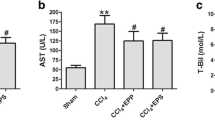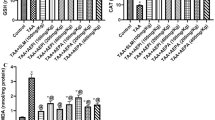Abstract
Citrus sinensis is a seasonal fruit. Its zester is rich in bioactive phytochemicals, such as limonene, β-sitosterol, and ascorbic acid, which possess pharmacological action. In this study, we report the effect of fraction prepared from dried peel of C. sinensis on biochemical and histopathological changes in rat model of liver cirrhosis. Liver cirrhosis was induced in rats by administering thioacetamide at a concentration of 0.03% in drinking water for 16 weeks. Thioacetamide was discontinued after 16 weeks and from the 18th week rats were given the extract orally for 9 weeks. Following the completion of the treatment, animals were killed and biochemical and histopathological changes associated with liver cirrhosis were evaluated. The treatment was found to reverse the elevated levels of alkaline phosphatase, γ-glutamyl transferase, and other biochemical markers related to oxidative stress and selected drug metabolizing enzymes. Histopathology of the hepatic tissue confirmed the curative effect of the extract, and corroborated with the biochemical findings. HPTLC fingerprinting of the test fraction confirmed the presence of limonene, β-sitosterol, and ascorbic acid, which may partially explain the effect. The extract was also found to possess the anti-proliferative activity, determined by measuring the incorporation of radioactive thymidine by the hepatic DNA. The study indicates the inhibitory action of the test preparation on collagen accumulation in the extracellular matrix, and hence suggests its use as a potential therapeutic agent in liver fibrosis and cirrhosis.






Similar content being viewed by others
References
Kris EPM, Hecker KD, Bonanome A et al (2002) Bioactive compounds in foods: their role in the prevention of cardiovascular disease and cancer. Am J Med 113:71–88
Silalahi J (2002) Anticancer and health protective properties of citrus fruit components. Asia Pac J Clin Nutr 11:79–84
Izquierdo AG, Gil MI, Ferreres F (2002) Effect of processing techniques at industrial scale on orange juice antioxidant and beneficial health compounds. J Agr Food Chem 50:5107–5114
Rouseff RL, Martin SF, Youtsey CO (1987) Quantitative survey of narirutin, naringin, hesperidin, and neohesperidin in citrus. J Agr Food Chem 35:1027–1030
Bocco A, Cuvelier ME, Richard H, Berset C (1998) Antioxidant activity and phenolic composition of citrus peel and seed extracts. J Agr Food Chem 46:2113–2129
Manthey JA, Grohmann K (2001) Phenols in citrus peel byproducts. Concentrations of hydroxycinnamates and polymethoxylated flavones in citrus peel molasses. J Agr Food Chem 49:3268–3273
Lodovici M, Guglielmi F, Meoni M, Dolara P (2001) Effect of natural phenolic acids on DNA oxidation in vitro. Food Chem Toxicol 39:1205–1210
Deyhim F, Lopez E, Gonzalez J et al (2006) Citrus juice modulates antioxidant enzymes and lipid profiles in orchidectomized rats. J Med Food 9:422–426
Miller EG, Sanders APG, Couvillon AM (1994) Citrus limonoids as inhibitors of oral carcinogenesis. Food Technol 48:110–114
Baker RA (1994) Potential dietary benefits of citrus pectin and fibre. Food Technol 11:133–139
Lam LKT, Zang J, Hasegawa S (1994) Citrus limonoid reduction of chemically induced tumorigenesis. Food Technol 48:104–108
Kaji I, Tatsuta M, Iishi H et al (2001) Inhibition by d-limonene of experimental hepatocarcinogenesis in Sprague-Dawley rats does not involve p21(ras) plasma membrane association. Int J Cancer 93:441–444
Gorinstein S, Leontowicz H, Leontowicz M et al (2007) Effect of hesperidin and naringin on the plasma lipid profile and plasma antioxidant activity in rats fed a cholesterol-containing diet. J Sci Food Agri 87:1257–1262
Tirkey N, Pilkhwal S, Kuhad A, Chopra K (2005) Hesperidin, a citrus bioflavonoid, decreases the oxidative stress produced by carbon tetrachloride in rat liver and kidney. BMC Pharmacology 5:2–10
Kaur G, Tirkey N, Chopra K (2006) Beneficial effect of hesperidin on lipopolysaccharide-induced hepatotoxicity. Toxicology 226:152–160
Shaw SR, Nihal M, Ahmad N (2007) Dose translation from animal to human studies revisited. FASEB J 22:261–659
Ali S, Pawa S, Naime M et al (2008) Role of mammalian cytosolic molybdenum Fe–S flavin hydroxylases in hepatic injury. Life Sci 82:780–788
Reitman S, Frankel S (1957) A colorimetric method for the determination of serum glutamate oxaloacetate transaminase. Am J Clin Pathol 28:53–56
Kind PRN, King EJJ (1954) Estimation of plasma phosphatase by determination of hydrolyzed phenol with aminopyrines. J Clin Pathol 7:322–326
Orlowski M, Meister A (1973) γ-Glutamyl cyclotransferase distribution, isozymic forms and specificity. J Biol Chem 248:2836–2844
Bernheim F, Bernheim MLC, Wilburn KM (1948) The reaction between thiobarbituric acid and the oxidation products of certain lipids. J Biol Chem 174:257–264
Jollow DJ, Mitchell JR, Zampagtrone N, Gillete JR (1974) Bromobenzene induced liver necrosis. Protective role of glutathione and evidence for 3, 4-bromobenzene oxide as the hepatotoxic metabolite. Pharmacology 11:151–169
Carlberg I, Mannervick B (1975) Purification and characterization of the flavoenzymes glutathione reductase from rat liver. J Biol Chem 250:5475–5480
Mohandas J, Marshall JJ, Duggin GG et al (1984) Differential distribution of glutathione and glutathione related enzymes in rabbit kidney. Possible implications in analgesic nephropathy. Biochem Pharmacol 33:1801–1807
Claiborne A (1984) Catalase activity. Handbook of methods in oxygen radical research. CRC Press, Boca Raton, pp 283–284
Stripe F, Corte DE (1969) The regulations of rat liver xanthine oxidase. Conversion in vitro of the enzyme activity from dehydrogenase (type D) to oxidase (type O). J Biol Chem 244:3855–3863
Habig WH, Pabst MJ, Fleischner G et al (1974) The identity of glutathione-s-transferase B with ligandin, a major binding protein of liver. PNAS 71:3879–3882
Galvez M, Cordero CM, Houghton PJ, Ayuso MJ (2005) Antioxidant activity of methanol extract obtained from Plantago species. J Agr Food Chem 53:1927–1933
Yamaguchi T, Takamura H, Matoba T, Terao J (1998) HPLC method for evaluation of the free radical-scavenging activity of foods by using 1, 1-diphenyl-2-picrylhydrazyl. Biosci Biotech Bioch 6:1201–1204
Smart RC, Huang MT, Conney AH (1986) Sn1, 2-diacylglycerols mimic the effects of TPA in vivo by inducing biochemical changes associated with tumor promotion in mouse epidermis. Carcinogenesis 7:1865–1870
Giles KW, Myers A (1965) An improved diphenylamine method for the estimation of deoxyribonucleic acid. Nature 206:93
Nissen NN, Martin P (2002) Hepatocellular carcinoma: the high-risk patient. J Clin Gastroenterol 35:79–85
Okita K, Sakaida I, Hino K (2002) Current strategies for chemoprevention of hepatocellular carcinoma. Oncology 62:24–28
Baek SH, Park M, Suh JH, Choi HS (2008) Protective effects of an extract of young radish (Raphanus sativus L) cultivated with sulfur (sulfur-radish extract) and of sulforaphane on carbon tetrachloride-induced hepatotoxicity. Biosci Biotech Bioch 72:1176–1182
Ali S, Ansari KA, Jafri MA et al (2000) Nardostachys jatamansi protects against liver damage induced by thioacetamide in rats. J Ethanopharmacol 71:359–363
Hunter AL, Holscher MA, Neal RA (1997) Thioacetamide-induced hepatic necrosis. I. Involvement of the mixed-function oxidase enzyme system. J Pharmacol Exp Ther 200:439–448
Bruck R, Shirin H, Aeed H et al (2001) Prevention of hepatic cirrhosis in rats by hydroxyl radical scavengers. J Hepatol 35:457–464
Bruck R, Schey R, Aeed H et al (2004) Protective effect of pyrrolidine dithiocarbamate in a rat model of liver cirrhosis. Liver Int 24:169–176
Ali S, Diwakar G, Pawa S et al (2001) Xanthine oxidase derived reactive oxygen metabolites contribute to liver necrosis: protection by 4-hydroxypyrazolo[3,4-d] pyrimidine. BBA-Mol Basis Dis 1536:21–30
Bruck R, Aeed H, Schey R (2002) Pyrrolidine dithiocarbamate protects against thioacetamide-induced fulminant hepatic failure in rats. J Hepatol 36:370–377
Pines M, Knopov V, Genina O et al (1997) Halofuginone, a specific inhibitor of collagen type I synthesis, prevents dimethylnitrosamine-induced liver cirrhosis. J Hepatol 27:391–398
Dasgupta A, Chatterjee R, Chowdhury JR (1981) Thioacetamide induced hepatocarcinoma in rat. Oncology 38:249–253
Oren R, Dotan I, Papa M et al (1996) Inhibition of experimentally induced cirrhosis in rats by hypothyroidism. Hepatology 24:419–423
Strnad P, Tao GZ, Zhou Q et al (2008) Keratin mutation predisposes to mouse liver fibrosis and unmasks differential effects of the carbon tetrachloride and thioacetamide models. Gastroenterology 134:1169–1179
Zimmermann T, Muller A, Machnik G et al (1987) Biochemical and morphological studies on production and regression of experimental liver cirrhosis induced by thioacetamide in Uje: WIST rats. Z Versuchstierkd 30:165–180
Fontana L, Moreira E, Torres MI et al (1996) Serum amino acid changes in rats with thioacetamide induced liver cirrhosis. Toxicology 106:197–206
Ortega MA, Torres MI, Fernandez MI et al (1997) Hepatotoxic agent thioacetamide induces biochemical and histological alterations in rat small intestine. Digest Dis Sci 42:1715–1723
Aris MI, Boyer JL, Fausto N et al (1994) The liver: biology and pathology. Raven Press, New York
Galisteo M, Suarez A, Montilla MP et al (2006) Protective effects of Rosmarinus tomentosus ethanol extract on thioacetamide-induced liver cirrhosis in rats. Phytomedicine 13:101–108
Xiangnong L, Irving SB, Barry A (2002) Reproducible production of thioacetamide-induced macronodular cirrhosis in the rat with no mortality. J Hepatol 36:488–493
Kubow S (1995) Routes of formation of toxic consequences of lipid oxidation products in foods. Free Radic Bio Med 12:63–81
Poli G (2000) Pathogenesis of liver fibrosis: role of oxidative stress. Mol Aspects Med 21:49–98
Galli A, Svegliati BG, Ceni E et al (2005) Oxidative stress stimulates proliferation and invasiveness of hepatic stellate cells via a MMP2-mediated mechanism. Hepatology 41:1074–1084
Stohr H, Herrmann K (1975) On the occurrence of derivatives of hydroxycinnamic acids, hydroxybenzoic acids, and hydroxycoumarins in citrus fruits. Zeitschrift für Lebensmittel-Untersuchung und-Forschung 159:305–306
Sarawek S, Feistel B, Pischel I, Butterweck V (2008) Flavonoids of Cynara scolymus possess potent xanthine oxidase inhibitory activity in vitro but are devoid of hypouricemic effects in rats after oral application. Planta Med 74:221–227
Maltzman TH, Hurt LM, Elson CE et al (1989) The prevention of nitrosomethylurea-induced mammary tumors by d-limonene and orange oil. Carcinogenesis 10:381–781
Crowell PL, Gould MN (1994) Chemoprevention and therapy of cancer by d-limonene. Crit Rev Oncol 5:1–22
Reicks MM, Crankshaw D (1993) Effects of d-limonene on hepatic microsomal monooxygenase activity and paracetamol induced glutathione depletion in mouse. Xenobiotica 23:809–819
Tedesco I, Russo GL, Nazzaro F et al (2001) Antioxidant effect of red wine anthocyanins in normal and catalase inactive human erythrocytes. J Nutr Biochem 12:505–511
Shi HL, Zhao BL, Xin WJ (1995) Scavenging effects of baicalin on free radicals and its protection on erythrocyte membrane from free radicals injury. Biochem Mol Biol Interact 35:981–994
Sini H, Devi KS (2004) Antioxidant activities of the chloroform extract of Solanum trilobatum. Pharm Biol 42:462–466
Acknowledgments
Authors acknowledge UGC for providing the infrastucture development grant to the Department of Biochemistry, Jamia Hamdard.
Conflict of interest
None.
Author information
Authors and Affiliations
Corresponding author
Additional information
This work belongs to the PhD thesis of R. Prasad carried under the supervision of S. Ali at Jamia Hamdard University.
About this article
Cite this article
Ali, S., Prasad, R., Naime, M. et al. Dried peel fraction of Citrus sinensis partially reverses pathological changes in rat model of liver cirrhosis. Mediterr J Nutr Metab 4, 57–67 (2011). https://doi.org/10.1007/s12349-010-0033-8
Received:
Accepted:
Published:
Issue Date:
DOI: https://doi.org/10.1007/s12349-010-0033-8




